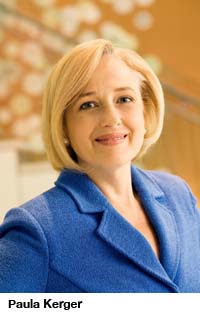Over the decades, the Public Broadcasting Service has distinguished itself as American television’s showcase of the arts. Culture-centric cable channels have come and gone, but PBS has “kept the flame alive,” in the words of Paula Kerger, the network’s president and chief executive officer.
But that flame has dimmed noticeably in recent years, as PBS’s cultural programming — which is expensive to produce and doesn’t necessarily draw the largest viewership — has gradually become marginalized. Arts programs can still be found on public television, but they aren’t as numerous as they once were, and — again to quote Kerger — they tend to be “strewn about” on station schedules.
That situation is set to change in a big way.
Speaking before Town Hall Los Angeles on Tuesday, Kerger recommitted PBS to arts programming, both on television and online. She described an ambitious arts initiative with three components:

• An online arts portal will be inaugurated on PBS.org in April.
• Plans are underway to shift the television schedule so one night of prime time programming per week will be devoted exclusively to the arts. Depending on the success of fundraising efforts, this will likely occur either this fall or next winter.
• New material is being developed for the PBS Teachers website to help instructors — especially those working in school districts where arts educators have been laid off — to incorporate the arts into the curriculum.
“We plan to significantly expand the presence of the arts in our prime time lineup,” Kerger told an audience of civic leaders and students. “This is critically important. Television remains the most popular form of mass media, even in the age of the Internet.
“To be candid, over the last years, we haven’t done as good a job (with cultural programming) as we could,” she said. “I think we can do more. We’re looking to increase the investment we’re making in the arts. The budget (for such programs) has been flat or slightly down. I want to ramp it up.”
Utilizing broadband video, the new online arts portal “will function as a 24-hour virtual performing arts venue,” she said.
“You’ll be able to drop in whenever you like and experience art of all kinds, including ballet, opera, theater and more.
“It’ll also be interactive, allowing you to interact with both established and emerging artists, as well as other arts enthusiasts around the world. You’ll be able to come to the showcase and create your own art, be it documentaries, virtual theater projects or something else.
“I want more arts programs, put in places where people can find them and archived online,” Kerger concluded. “If we can put those pieces together, it’ll have more impact and, hopefully, create an audience for more.”
Kerger, who became PBS’s sixth president and CEO in 2006, said she considers arts programming fundamental to the network’s central goal, “to help citizens of all ages to be more informed, more creative, more curious.”
“As federal and state support for the arts declines, I think it is up to PBS and its member stations to keep Americans connected to the arts,” she said. Referring to the Los Angeles Philharmonic’s charismatic new music director, she added: “If young Americans don’t learn about Debussy, Degas and Dudamel in the classroom, let’s make it possible for them to come to PBS and experience their work.”
Sign up for our free e-newsletter.
Are you on Facebook? Become our fan.
Follow us on Twitter.



